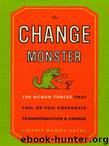The Change Monster: The Human Forces That Fuel or Foil Corporate Transformation and Change by Jeanie Daniel Duck

Author:Jeanie Daniel Duck [Duck, Jeanie Daniel]
Language: eng
Format: mobi
Publisher: The Crown Publishing Group
Published: 2001-07-29T14:00:00+00:00
THE CHIEF COMMUNICATOR BECOMES THE DE FACTO SHAPER OF CHANGE
Sometimes, an unexpected individual emerges as a strong and influential communicator. In one company, it was the Chief Technology Officer (CTO). After every executive committee meeting or any other important gathering, the CTO would send to his direct reports a voice mail giving his interpretation of the events, including his views on discussions and decisions. His direct reports loved getting these voice mails. They made them feel that they had a direct link to the inner sanctum. And, to show their privileged status of “being in the know,” they quickly passed the voice mails to others—and so on and so on, until 70 percent of the division was listening to these voice mails. Furthermore, because they were unofficial (and because of the mystique that each person only got them because of his or her status), these messages were deemed the most credible communications of any within the company.
When we informed the executive committee members about the voice-mail phenomenon as part of our communications analysis, most of them were stunned. The CTO feigned surprise; I’m convinced, however, that he had worked tirelessly to build his following. The voice mails (and similar e-mails) were never marked “private” or restricted in any way that would prevent their being passed on. He was not only Chief Technology Officer but, by default, Chief Communicator. Too bad he and the CEO didn’t see eye-to-eye on many critical issues.
The Chief Communicator, whoever it may be, will often become the de facto shaper of the change. In one merger, for example, the Change Team in the acquired company organized a toll-free telephone number with a new message every morning and afternoon, as well as answers to frequently asked questions. The acquirer, on the other hand, had no such service, and its written communications were infrequent and ineffective. Word of the toll-free number immediately spread, and people from both organizations began bombarding it with calls. It came to be regarded as the best source of merger information. As a result, the acquired company significantly influenced not only the messages but the attitudes and beliefs of both sets of employees and even the course of the merger itself.
Download
This site does not store any files on its server. We only index and link to content provided by other sites. Please contact the content providers to delete copyright contents if any and email us, we'll remove relevant links or contents immediately.
Bad Blood by John Carreyrou(6274)
Rich Dad Poor Dad by Robert T. Kiyosaki(6174)
Principles: Life and Work by Ray Dalio(5961)
Playing to Win_ How Strategy Really Works by A.G. Lafley & Roger L. Martin(5497)
Management Strategies for the Cloud Revolution: How Cloud Computing Is Transforming Business and Why You Can't Afford to Be Left Behind by Charles Babcock(4438)
The Confidence Code by Katty Kay(4036)
Thinking in Bets by Annie Duke(3996)
American Kingpin by Nick Bilton(3507)
Delivering Happiness by Tony Hsieh(3280)
Project Animal Farm: An Accidental Journey into the Secret World of Farming and the Truth About Our Food by Sonia Faruqi(3017)
The Power of Habit by Charles Duhigg(2966)
Brotopia by Emily Chang(2892)
Mastering Bitcoin: Programming the Open Blockchain by Andreas M. Antonopoulos(2891)
The Tyranny of Metrics by Jerry Z. Muller(2846)
I Live in the Future & Here's How It Works by Nick Bilton(2844)
The Marketing Plan Handbook: Develop Big-Picture Marketing Plans for Pennies on the Dollar by Robert W. Bly(2793)
The Content Trap by Bharat Anand(2778)
Building a StoryBrand by Donald Miller(2754)
Applied Empathy by Michael Ventura(2749)
